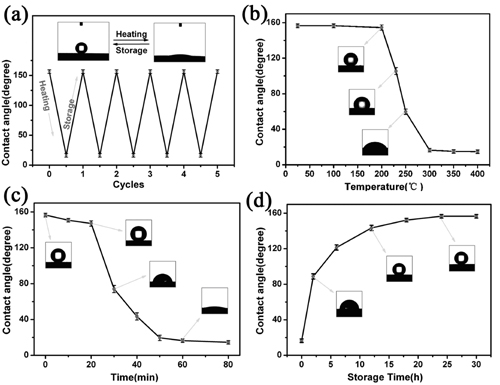
(a) Reversible superhydrophobicity and superhydrophilicity transitions of the carbon nanotube film obtained by alternating heating and air storage. Influence on the contact angle of the carbon nanotube film of (b) heating temperature, (c) heating time, and (d) storage time.(Image by ZHANG Zhaozhu et al.)
The wettability of carbon nanotube (CNT) surfaces has been the subject of extensive investigations because of its potential applications. Due to the special nanostructures and surface properties of CNTs, further surface functionalization or textured arrangement could facilitate easy control of their wetting properties. There are several methods to induce the transition of CNT surface from superhydrophobic to superhydrophilic, such as acid treatment, electric field inducement, UV irradiation, oxygen plasma etching, and surface functionalization.
Recently, the research group headed by Prof. ZHANG Zhaozhu of the Lanzhou Institute of Chemical Physics (LICP), CAS, show that heat treatment can also modify the pristine CNT wettability in an easy and tunable way. Researchers fabricated a superhydrophobic CNT film by a simple spray-coating method without any chemical modification. The contact angle reaches a high value of 155 ± 1° on the film. A remarkable surface wettability transition between superhydrophobicity and superhydrophilicity can be easily observed by the alternation of heating and air storage. The transition may be attributed to the change of electronic structures of carbon nanotubes since the surface structure and composition after treated remain the same as the pristine carbon nanotubes.
The work is significant in that the switchable wettability on the CNT surfaces could have potential applications in areas requiring multifunctional CNT-based films.
The work has received support from the National Natural Science Foundation of China. The findings have been published in Carbon (Carbon 2011, 49, 19–23)
Carbon Paper

